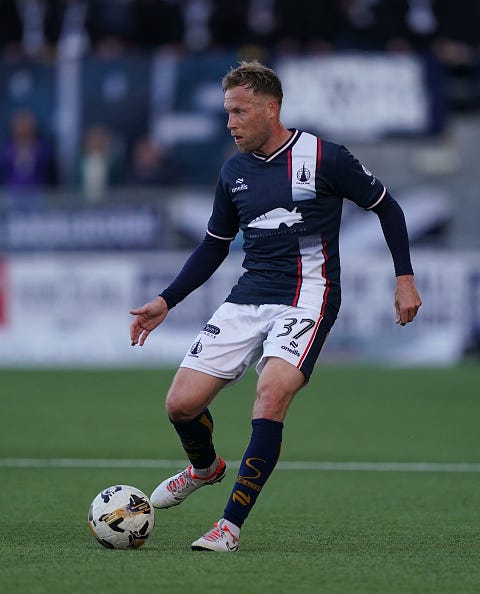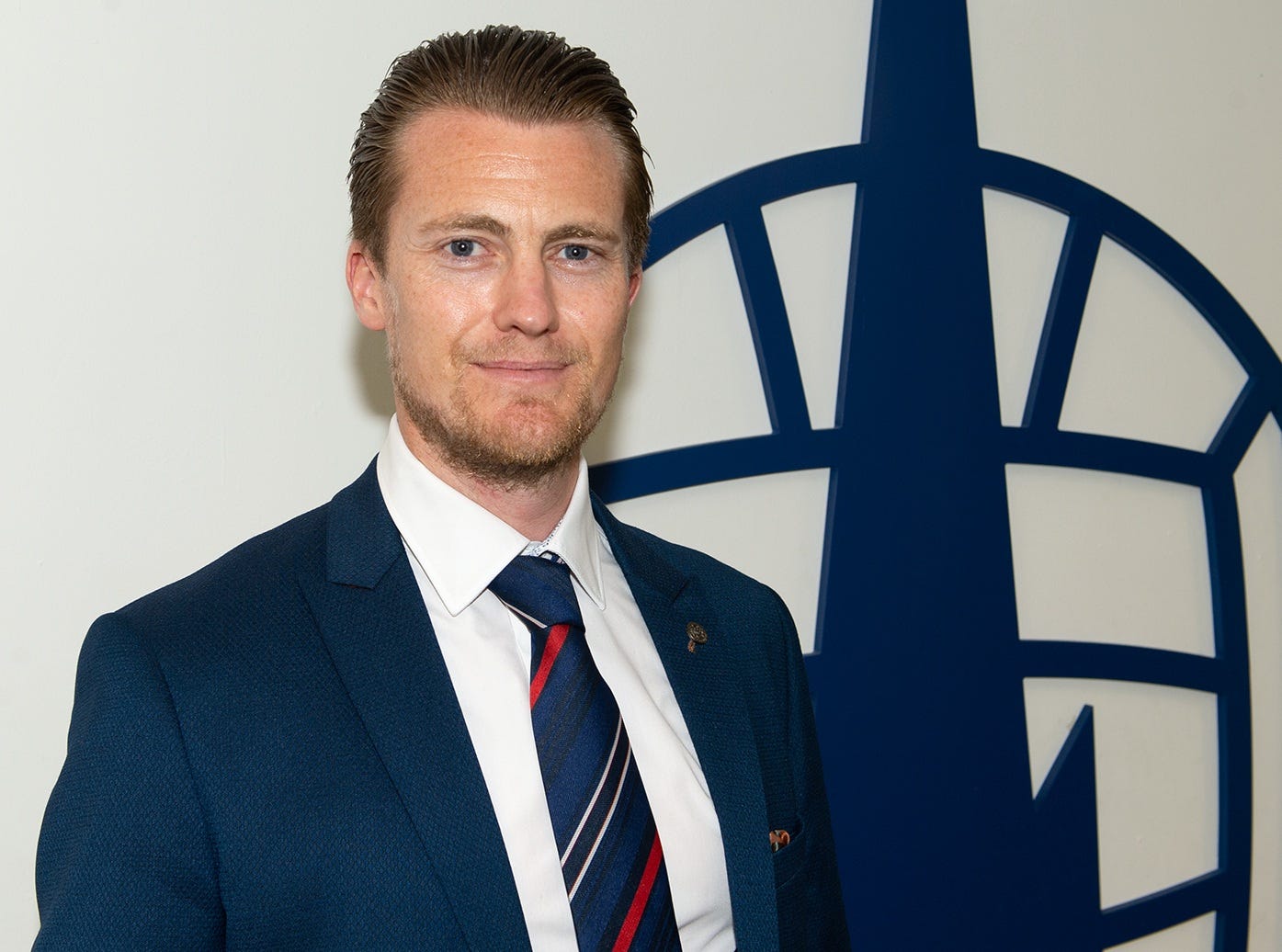PLASTIC PITCHES #1: 🗣️ "Fans, pundits, players, managers will come here and talk about that being a really good pitch"
With a quarter of next season's Premiership clubs set to play on synthetic grass, Falkirk CEO Jamie Swinney goes on the offensive
Award-winning sportswriter Stephen McGowan continues his new monthly investigations series with an examination of the pros and cons of artificial surfaces. Plastic is loved by the few, loathed by the many, so Bairns chief executive Jamie Swinney explains how he aims to change hearts and minds.
🗣️ Tomorrow: Part II — A view from Norway, where the climate means that 12 out of the 16 top-flight clubs play on astro, including Europa League semi-finalists Bodø/Glimt.
🗣️ Friday: Part III — Livingston’s promotion brings the Premiership’s number of artificial surfaces up to three. Stephen investigates what the future holds for those clubs
Parts two and three are for paid subscribers only.
Been waiting for right moment to support our indie journalism? This is it…
By Stephen McGowan
Falkirk have spent 15 years completing the long and winding road back to the Scottish Premiership. On reaching their destination, the admission fee feels unreasonably steep.
In an ideal world, John McGlynn’s side hope to become a top-six club and challenge for a place in Europe. All of this would be pricey and difficult enough without the added cost of laying down a new grass pitch in close season 2026.
Loved by the few, loathed by the many, their fellow clubs have voted to outlaw artificial surfaces in the top flight from season 2026/27.
A grace period of 12 months to replace their synthetic surface feels like the smallest of mercies. Natural turf will cost around £1.2million and, while discussions have taken place with the SFA over interest-free loans or grants to help with the cost, the annual maintenance bill for a grass surface is around £300,000.
With the Championship trophy resting on a table in the middle of his office, Bairns chief executive Jamie Swinney nods towards the playing surface outside as he tells Nutmeg: “I actually look forward to clubs coming here next season and saying, ‘That’s a good pitch you have here at Falkirk’, because that’s what will happen.
“Clubs will come here and fans, pundits, players and managers will talk about that out there being a really good pitch.”
That’s a view unlikely to draw much agreement from those who believe football is a sport played on grass.
Fans of Celtic and Rangers watch their team struggle on Kilmarnock’s surface and curse its existence.
Newly-promoted Livingston’s pitch passed its use-by date in the summer of 2023. Prompted by the SPFL, the West Lothian club will lay down a new artificial surface, utilising the latest MX Elite woven system, in time for next season.
“Right now, our astroturf needs replaced because it is at the end of its lifecycle”, manager David Martindale acknowledges.
“The same applies to Raith Rovers and to Hamilton.
“The Oriam [Scotland’s Sports Performance Centre], Falkirk and Airdrie have the next generation.
“And I think if you asked a Hearts player, ‘Would you rather play against Falkirk on their artificial surface or against St Johnstone on their grass surface?’ then most players would tell you Falkirk.
“Our winters have grown colder or harsher with more rain and it’s extremely hard for clubs which don’t have huge fan bases to throw money at a grass park.”
In a plea for regulation rather than prohibition, Swinney submitted an “alternative proposal” to the SPFL in March 2024 on behalf of Falkirk, Airdrie, Cove Rangers, Hamilton, Livi, Queen of the South and Raith Rovers. In it, he argued the case for “significantly improving the quality, consistency and perception of artificial surfaces within the SPFL.”
Perception is an important word in this debate. While the surfaces in place at Livingston and Kilmarnock are perceived to be unsatisfactory, Falkirk, Airdrie and Raith Rovers believe theirs meet the gold standard FIFA Quality Pro criteria.
And, should they be forced to make the switch then they want the SFA to provide financial assistance.
Talks over a proposed package of fiscal help stalled when top-flight clubs voted against a proposal to redistribute UEFA solidarity money to teams in the Championship. If agreement can’t be reached, the seven clubs reserve the right to have the ban reviewed by an independent arbitration tribunal under Article 99 of the governing body rules.
“Our proposal was that a pitch could be no older than four years old because, like anything, they do deteriorate through time”, Swinney acknowledges.
“You had to limit usage in the Premiership to your first team to ensure it was not sustaining too much wear and tear.
Basically, you would need a Champions-League quality pitch
“You would have to buy the highest-quality pitch. Basically, a Champions-League quality pitch. And you must get it tested four times a year.
“If clubs wanted to be in the Premiership with an artificial pitch, they would need to hit the same standard as ours.”
The paper advocated approved contractors being used for every installation. Every surface would be held to the standard of the FIFA Pitch Pro Advanced testing programme, ensuring it was up to the standard expected of the UEFA Champions League and other club competitions.
An approved pitch maintenance plan with four spot checks and two deep cleans a season would have been mandatory. Every pitch would require its own irrigation system and would need to demonstrate an approved method of frost/snow protection via an inflatable bubble or snow covers.
“If they didn’t meet that they didn’t get in”, adds Swinney. “All the clubs we have been talking to about this agreed with those criteria and we put the paper in collectively.
“We were all in agreement and the right thing to do for Scottish football would have been to say, ‘We don’t have the highest-quality grass pitches, so why not pause for two years, apply strict criteria on artificial surfaces and use the two years to understand why our grass pitches are failing?”.
This season, St Johnstone’s grass playing surface raised eyebrows among opposition clubs and fans. Champions Celtic slid to a rare defeat at McDiarmid Park on a day when a dry, bobbly surface appeared to have an impact on their passing.
“There’s not even a criteria for grass pitches at the moment”, points out Swinney. “They simply need to be grass, nothing else. How bad is that?
“Three weeks after Scott Arfield joined us in January, I asked him out of curiosity, ‘What are your thoughts on the pitch?’.
“And he said to me, ‘I can’t believe how good it is for an artificial pitch. It’s a lot better than I thought it would have been.’
“Now, this is a guy who has played at a very, very high level.
“Are you trying to tell me that a guy would rather go out on some of the pitches we have seen in December, January or February and play there with no grass on some sections, or go out and know how it will bounce, how it will roll on a pitch with water?
“I just don’t believe that players would choose some of the grass pitches we have seen in the Premiership over what we have to offer.”

Scotland’s climate offers no guarantees of grass growing as it should. In 2010, Motherwell were fined £50,000 over the state of their pitch.
In April last year, Dundee were fined a total of £186,000 over a series of postponements caused by a waterlogged Dens Park pitch.
All of this poses a problem for the clubs seeking assistance to lay down grass. When clubs in the Premiership have spent millions upgrading and maintaining or relaying their pitch, they see no reason why they should subsidise others doing the same via grants or SFA loans.
Speaking on condition of anonymity, one Premiership official told Nutmeg: “There should be no loans to lay grass pitches unless you also give loans to clubs who have always managed to maintain a grass pitch both at their stadium and on their training ground and academy.
“These clubs save a six-figure sum every year by having an artificial pitch. It’s hard to see how that fails to give them an advantage over Ayr, Partick Thistle, Dunfermline and others.
“So not only have they benefitted from that financial and competitive advantage, now they want the game to dig deep and pay for their new grass pitch.”
The issue may yet descend into another ugly and polarised dispute between clubs with conflicting interests.
“Before we reach the point of seeking arbitration from the SFA we are asking for financial support”, states Swinney.
“The Premiership take everything, 84% of the pot and all the solidarity money and all the extra money that comes into the sport from Premier Sports for extra games.
“And then they tell Championship clubs struggling to survive that we need to rip up our £350k pitch and put in a £1million pitch…”
As part of the paper from March last year, the clubs with artificial turf asked what Scottish football might learn from UEFA and FIFA, who have permitted artificial surfaces at the highest levels of club and international competition. Or, for that matter, what Scotland could learn from other countries with a similar climate and with leagues which operate within similar economic constraints.
One of those countries is Norway. Tomorrow Nutmeg FC takes a look at how they approach the issue.


